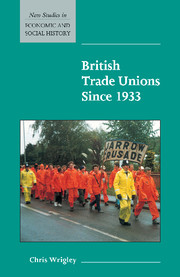Book contents
- Frontmatter
- Contents
- List of tables
- 1 Introduction
- 2 Economic recovery and war, 1933–1945
- 3 Trade union development, 1945–2000
- 4 Strikes, 1945–2000
- 5 Incomes policies, 1948–1979
- 6 Trade union legislation, 1945–2000
- 7 What have trade unions done?
- List of references
- Index
- Studies in Economic and Social History
- New Studies in Economic and Social History
3 - Trade union development, 1945–2000
Published online by Cambridge University Press: 05 June 2012
- Frontmatter
- Contents
- List of tables
- 1 Introduction
- 2 Economic recovery and war, 1933–1945
- 3 Trade union development, 1945–2000
- 4 Strikes, 1945–2000
- 5 Incomes policies, 1948–1979
- 6 Trade union legislation, 1945–2000
- 7 What have trade unions done?
- List of references
- Index
- Studies in Economic and Social History
- New Studies in Economic and Social History
Summary
The trade unions expanded until 1979, then contracted until 1998, after which there was a period of stabilisation (see Tables 3.1 and 3.2). From their early days, in the eighteenth century, onwards the trade unions' membership has changed as occupational groups have risen and fallen in size and significance in the economy. The trade unions' membership changed during their good years (1945–79) as well as afterwards (1980–2000). Both periods saw substantial trade union mergers, with the post 1979 period seeing large unions needing to merge in order to maintain their organisations and their services to members as the size of their memberships declined. In adverse conditions trade unions had to be more responsive to members' needs, to offer more and better services to secure their loyalty when the tangible benefits of trade union membership were less apparent but the dangers of being a trade union member were greater in a politically and economically hostile climate.
Trade union membership: expansion, 1946–79
British trade union membership reached its peak in 1979. Trade union membership rose from 8,603,000 in 1946 (the first full post-war year) to 12,639,000 in 1979. In terms of trade union density this was a rise from 43.0 per cent to 53.4 per cent, with male trade union density rising from 51.9 to 63.1 per cent and female trade union density from 24.3 to 39.4 per cent (Table 3.1).
- Type
- Chapter
- Information
- British Trade Unions since 1933 , pp. 18 - 39Publisher: Cambridge University PressPrint publication year: 2002

